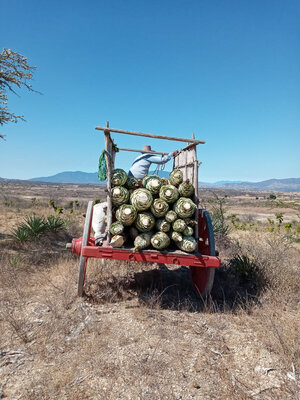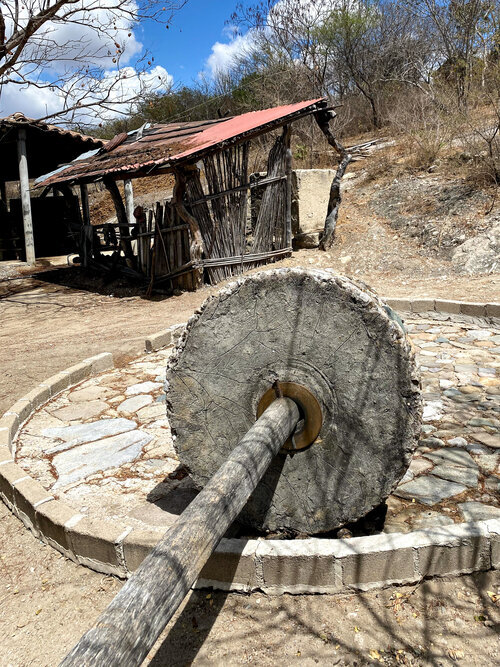Madrecuixe Puntas
56.5%
Felipe Cortes, Mengoli de Morelos, Miahuatlán Oax.
There’s a technical reference and cultural history to puntas, both of which are important to understanding this bottle. If you’re a “just the facts” type, please skip ahead.
There’s also the experience of drinking puntas. The “wow" part that can’t be captured by technical details, but somehow proves them. We all know the high school chemistry definition of distillation - to separate a liquid into its elemental parts. I don’t know what we would imagine distilled spirits to be like if all we knew was that definition, but probably something a lot like puntas.
Puntas are the platonic ideal that we imagine spirits to be. Agave, boiled down to its very essence, the plant stripped of everything but its soul. The most ethereal, intense but subtle spirits we’ve ever tasted. The flower breathing dragon. Magnús Ver Magnússon in a yoga pose. The daiginjo of the maguey.
Agave Spirits Composition for Dummies:
Puntas: High ABV, little to no aromatics, light body, intense amounts of light and delicate flavors
Corazones: Medium ABV, Medium aromatics, Medium body to heavy body, medium amount of various flavors
Colas: Low ABV, highly aromatic, light to oily body, bitter flavors
A quick primer on the term puntas:
Translated as “points” or “tips,” puntas are the first drinkable part of the distillate to come off of the still followed by the corazones or “hearts,” and finally the colas or tails. Though the three categories are most often compared in terms of their percentages of alcohol (puntas > corazones > colas), they also have extremely different aromas, flavors, and textures.
A finished batch of agave spirits is composed of the corazones adjusted with some portion of the of the puntas and colas. Exactly how much of each to include is an art that balances the desire for, say, more aromatics against the desire not to make the batch overly bitter or low ABV. It’s the most personal part of the production process, as every mezcalero has his own palate.
Traditionally, puntas are not sold on their own or consumed for recreation, though they're a home remedy for everything from an upset stomach (drink a few ounces), to back aches and mosquito bites (applied as a topical ointment), to pneumonia (Vick’s Vapor Rub style). When visiting a mezcalero over 55, ask if he has any puntas, and 8 out of 10 times, you’ll be met with the same dad joke - "bee-agra" said with a wink and a flexed forearm.
This Batch of Puntas
It’s always a surprise to find a mezcalero sitting on more than a few liters of puntas that aren’t needed for some larger batch. In our experience, this usually means there’s a sad story about a jug of corazones that got spilled or a distillation that went wrong - something that prevented the puntas from getting mixed in with the rest of the distillate.
In this case, Felipe is a sharp old guy, and having seen how interested tourists and non-local visitors were when tasting the little bits of puntas he had around the palenque, he decided it might be worth reserving some to sell. He was correct.
Of course, keeping 60+ liters of 56.5% madrecuixe puntas on their own means there’s a much larger batch of 48% madrecuixe that didn’t get made. We asked him how he decides which batches he wants to be sell as puntas instead of 48% spirits. "Usually, if there is a small amount of a type of maguey or if I have a little extra that doesn’t go in the oven with the rest, I think about doing something special with it.” In this case, that special something was a few garrafones of puntas, and a couple of pechugas made with remaining corazones and colas."
Felipe Cortes shows off the field beside his home in Mengoli de Morelos, Miahuatlán
Felipe Cortes hauls madrecuixe piñas from the field to the palenque
Felipe Cortes refills the refrescadera on his alambique
Madrecuixe Capón
Felipe Cortes's bueyes enjoying a day off
The tahona at Felipe Cortes's palenque waits for the next batch of agave.
Sunset at Felipe Cortes's rancho
Agave ferments in Felipe Cortes's sabino wood tina, weighed down with wood and stones to keep it from bubbling out.
Felipe Cortes relaxing at home in Mengoli de Morelos, Miahuatlán












